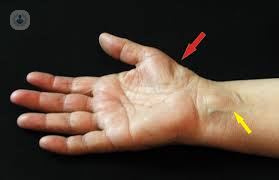When do I need to remove a lipoma?
Written by:A lipoma is a benign fatty lump. Lipomas can occur anywhere the body stores a layer of fatty tissue. Most are found beneath the skin and in front of the underlying layer of muscle, occasionally they can occur between muscles. It’s very rare for a lipoma to be cancerous. When they are cancerous, we call them sarcomas. Mr James Kirkby-Bott tells us a little bit about what causes lipomas and if we need to have them removed.

Are lipomas painful?
Most lipomas are not painful, however, some lipomas can feel tender like a bruise, but it depends entirely on the mix of cells that are within the lipoma. Those that feel tender are called angiolipomas.
The type of lipoma can only be distinguished by looking at the cells under a microscope and not with imaging techniques. Angiolipomas tend to occur as part of an inherited or genetic syndrome, usually on the limbs.
What causes a lipoma?
Most lipomas occur by chance and can depend on your particular genes and how they have interacted with your environment. There are some rare genetic syndromes that cause multiple small lipomas, usually on the limbs and torso. These syndromes run in families and mostly affect men in the families affected. They are passed down in an autosomal dominant manner, which means that the offspring of a person with the condition will have a 50% chance of having the gene and having the gene can cause multiple lipomas.
One of these syndromes is called Dercum's disease. This causes angiolipomas, which can be sore when touched. The other syndrome is called multiple lipomatosis syndrome, which usually doesn’t cause angiolipomas, so it is not a painful condition.
Multiple endocrine neoplasia syndromes: type 1, 2a and 2b also have an increased incidence of lipoma type lumps. They tend not to cause symptoms and are generally found when performing scans for other conditions.

When would a lipoma need to be removed?
Most lipomas are removed for cosmetic reasons or because they cause slight discomfort, so in most cases, they do not qualify for NHS funding to be removed and have to be removed privately.
Some lipomas can become quite large and if they are more than 5cm in size or have other suspicious features, they should be evaluated to ensure they are benign. This is done with an ultrasound scan initially and sometimes with an MRI. If reports come back with suspicious findings, then a core biopsy is performed under local anaesthetic. After the biopsy, a diagnosis will be made, but most doctors will remove a lipoma that is quite large to prevent them from growing any bigger.
Angiolipomas that cause discomfort can be removed, but if you are a patient with Dercum's disease, it’s best to have tender lumps removed in batches every 18-24 months. Removing more than six lipomas in any one go is not advised, as this can cause a lot of post-operative pain.
How is a lipoma removed?
Smaller lipomas are removed under local anaesthetic as a routine procedure. Larger lipomas require a general anaesthetic, but can also be done as a day case. Everyone will experience bruising and will have a scar after the operation.
Risks are low and complications are uncommon. However, like with any operation, there are always some risks such as recurrence or infection. It is uncommon, but occasionally fluid can fill the space where the lipoma was removed, forming a lump called a seroma. The bigger the space after removing the lipoma the more likely you are to develop a seroma.
As the wound heals up, the risk of developing a seroma decreases and any fluid collected is reabsorbed. Seromas can be troublesome when they occur. It is tempting to drain them, but if repeatedly drained, can lead to infection or a cyst wall developing that then needs removing later.
As we’ve seen, most lipomas are benign and removed solely for aesthetic reasons. However, if you have a lipoma that is quite large and causing you some discomfort, it’s better to have it looked at by a specialist like Mr James Kirkby-Bott.


